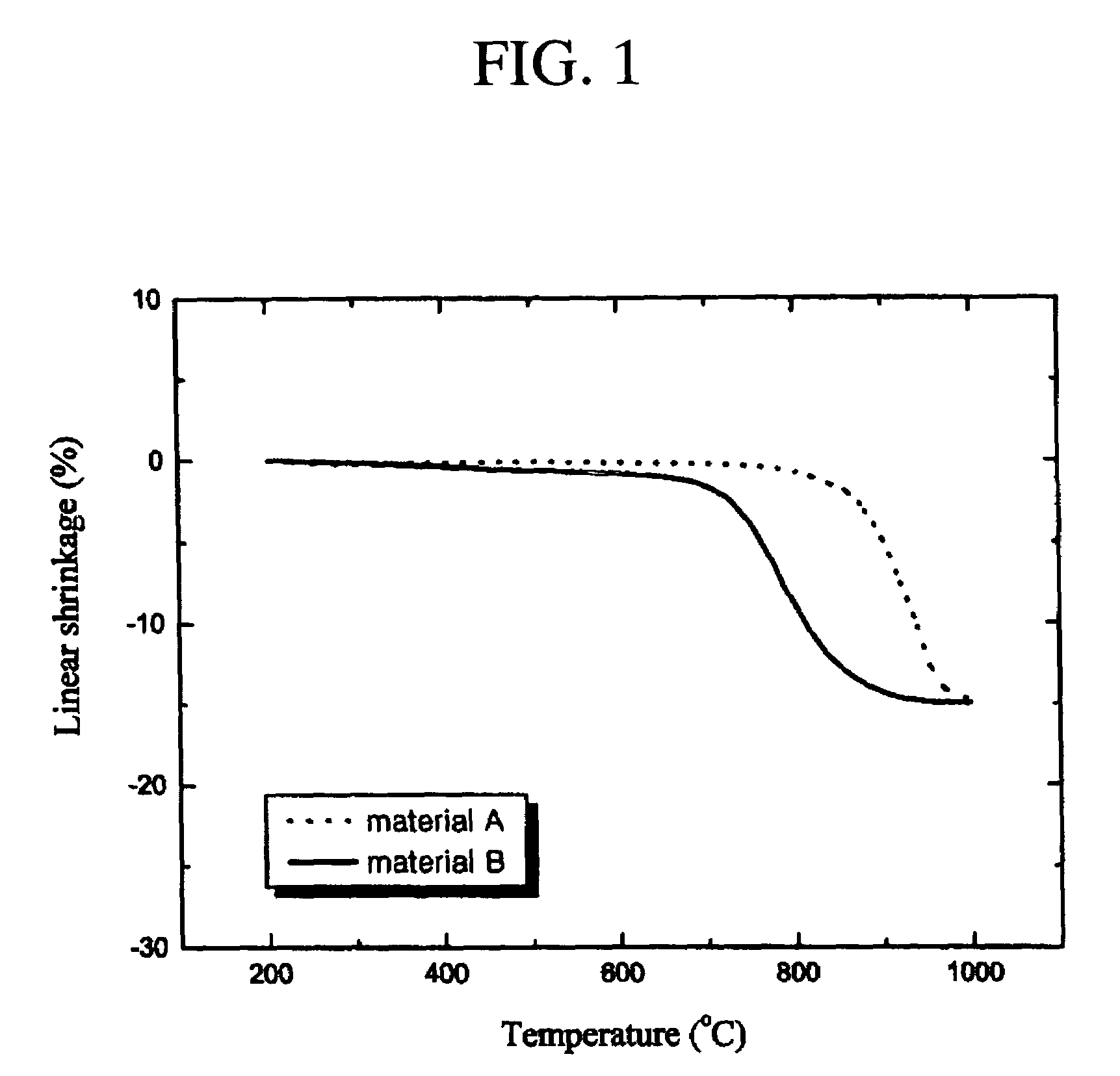Low dielectric constant low temperature fired ceramics
a low temperature fired ceramic and low dielectric constant technology, applied in the field of dielectric ceramics, can solve the problems of high dielectric loss value and above 0.1%, and achieve the effect of low dielectric loss and easy glass formation
- Summary
- Abstract
- Description
- Claims
- Application Information
AI Technical Summary
Benefits of technology
Problems solved by technology
Method used
Image
Examples
embodiment 1
[0032]First compositions such as below Table 1 was checked in order to determine an adequate mixture ratio between SiO2 and B2O3 which largely affect glass formation and its characteristics.
[0033]In a state that a content amount of Al2O3 and alkaline earth metal oxide was fixed constant, the content of SiO2 was changed to 62–72% and the content of B2O3 was changed proportionally.
[0034]Among alkaline earth metal oxide, MgO and CaO were selected and added in the same ratio.
[0035]First, it was checked whether glass melting is properly made at a temperature of 1600° C., and a glass transition temperature (Tg) and a softening temperature (Ts) were checked from an inflection point measured by a dilatometer.
[0036]And then, an electrode was formed at a glass pallet and its electrical property was measured by an LCR meter, a result of which are as shown in below Table 1.
[0037]
TABLE 1Physical and electrical propertiesdielectricdielectricSampleGlass Composition (Mole %)MeltingTg (° C.) / constan...
embodiment 2
[0042]The content of SiO2 was fixed at 70% and the content of B2O3 and Al2O3 was constantly maintained. Alkaline earth metal oxide was changed to MgO, CaO, SrO and ZnO and their characteristics were checked. Table 2 exhibits physical and electrical properties.
[0043]
TABLE 2Physical and electrical propertiesdielectricdielectricSampleGlass Composition (Mole %)MeltingTg (° C.) / constantloss (%)NoSiO2B2O3Al2O3MgOCaOSrOZnO(at 1600° C.)Ts (° C.)(@ 1 MHz)(@ 1 MHz)2A70.0022.002.003.003.00——crystallization610 / 7054.260.212B70.0022.002.003.00—3.00—◯614 / 7124.330.252C70.0022.002.003.00——3.00crystallization597 / 7054.100.172D70.0022.002.00—3.003.00—◯687 / 7574.430.152E70.0022.002.00—3.00—3.00◯637 / 7184.200.052F70.0022.002.00——3.003.00Δ638 / 7184.280.17
[0044]Addition of MgO is judged to be not preferred because glass is not formed during the process of quenching a melt glass and instead crystallization was made.
[0045]Addition of SrO is judged to be also not preferred because it happens that the glass trans...
embodiment 3
[0048]The content of SiO2 was fixed at 70% and the contents of B2O3 and Al2O3 were also maintained constant. ZnO and CaO was selected as alkaline earth metal oxide additive. While their sum is maintained 6 mol %, a mixture ratio was changed, a result of which is as shown in below Table 3.
[0049]
TABLE 3Physical and electrical propertiesdielectricdielectricSampleGlass Composition (Mole %)MeltingTg (° C.) / constantloss (%)NoSiO2B2O3Al2O3CaOZnO(at 1600° C.)Ts (° C.)(@ 1 MHz)(@ 1 MHz)3A70.0022.002.000.006.00◯614 / 7014.0520.213B70.0022.002.001.005.00◯622 / 7094.1020.163C70.0022.002.002.004.00◯625 / 7104.1530.133D70.0022.002.003.003.00◯637 / 7184.2040.063E70.0022.002.004.002.00◯650 / 7274.2550.073F70.0022.002.005.001.00◯664 / 7374.3060.143G70.0022.002.006.000.00◯684 / 7554.3060.15
[0050]Melting was easily made at the temperature of 1600° C. and a glass transition temperature was 700–760° C. An electrical property of a measured glass test sample shows a dielectric constant of 4.0–4.4, a low regular dielect...
PUM
| Property | Measurement | Unit |
|---|---|---|
| Temperature | aaaaa | aaaaa |
| Temperature | aaaaa | aaaaa |
| Shrinkage | aaaaa | aaaaa |
Abstract
Description
Claims
Application Information
 Login to View More
Login to View More - R&D
- Intellectual Property
- Life Sciences
- Materials
- Tech Scout
- Unparalleled Data Quality
- Higher Quality Content
- 60% Fewer Hallucinations
Browse by: Latest US Patents, China's latest patents, Technical Efficacy Thesaurus, Application Domain, Technology Topic, Popular Technical Reports.
© 2025 PatSnap. All rights reserved.Legal|Privacy policy|Modern Slavery Act Transparency Statement|Sitemap|About US| Contact US: help@patsnap.com


